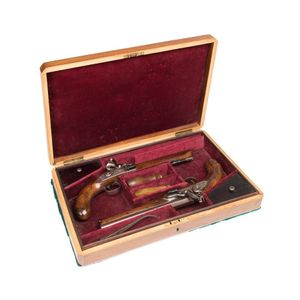Victorian Mother of Pearl Dressing Box
You must be a subscriber, and be logged in to view price and dealer details.
Subscribe Now to view actual auction price for this item
When you subscribe, you have the option of setting the currency in which to display prices to $Au, $US, $NZ or Stg.
- Rosewood - A dense timber that varies in shade to very light brown to almost black. When rosewood is cut and sanded the colour of the timber will turn black, and after polishing and exposure to daylight, the surface will gradually lighten over time to light brown with black streaks.
The name comes from the odour emanating from the timber when it is planed, sanded or cut.
Rosewood was very popular for use in Victorian furniture in the second half of the 19th century, and at that time most of the rosewood was imported from Brazil. However it also grows in India and Indonesia.
It is used in the sold for chairs and table legs, but for carcase furniture such as side cabinets and bookcases, and for table tops it is always used as a veneer. - Mother-Of-Pearl - Mother-of-pearl, technical name "nacre", is the inner layer of a sea shell. The iridescent colours and strength of this material were widely used in the nineteenth century as an inlay in jewellery, furniture, (especially papier mache furniture) and musical instruments.
In the early 1900s it was used to make pearl buttons. Mother-of-pearl is a soft material that is easily cut or engraved.
Nowadays it is a by-product of the oyster, freshwater pearl mussel and abalone industries. - Circa - A Latin term meaning 'about', often used in the antique trade to give an approximate date for the piece, usually considered to be five years on either side of the circa year. Thus, circa 1900 means the piece was made about 1900, probably between 1895 and 1905. The expression is sometimes abbreviated to c.1900.
This item has been included into following indexes:
Visually similar items

A pair of flintlock duelling pistols by Simmons of London; with powder flask & tools housed in fitted walnut case, early 19th century.

A Victorian jewellery accoutrements box c.1880's, rosewood with mother-of-pearl inlay the box has a silk, fabric inner lining, with lift-out multi compartment storage tray. Height 12.5 cm. Length 28 cm. Width 19.5 cm

Early Thorens music box. Floral marquetry to lid. 6 airs. Functional. Provenance: Australian collector. Length 45 cm

Victorian rosewood cased gentlemans travel case with a hinged lid & single drawer & an internal pull out compartment & a Bramah London lock, the interior containing ten various sized glass containers, nine with English hallmarked sterling silver lids. Lond
